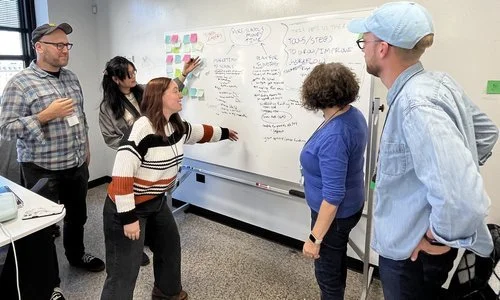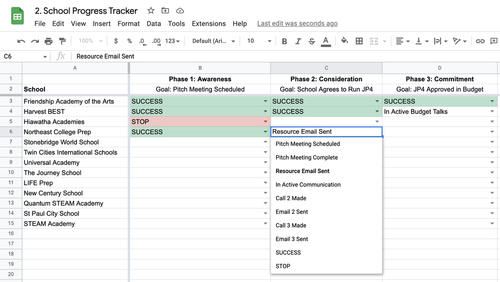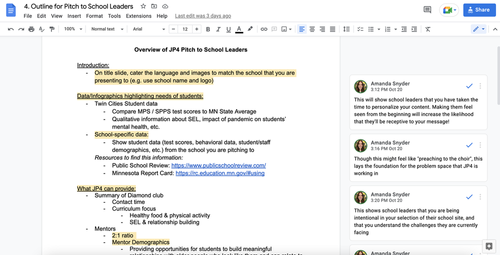JP4 Foundation
Client: JP4 Foundation
Roles: UX Researcher, Strategist, UX Designer, Presenter
Methods: Secondary Research, Stakeholder Walkthrough, Personas, Sketching, Touchpoint Strategy Map
Tools: Figma, Google Sheets, FigJam, iMovie
Team: Michael Roth, Morgan May, Amanda Snyder, Mica Mei Kwan
The Brief:
Help devise a UX strategy for a non-profit organization providing after school programs for underserved youth.
What I Did:
I was the primary researcher for this project and I took a deep dive into finding information regarding Charter Schools, guiding the strategy and timeline for implementing after school programming and outreach.
Introduction
The non-profit JP4 Foundation serves two charter schools with high needs in the Twin Cities with after school programming. They provide heathy food to each child that attends their program and a healthy, fun activity to do. Each child is assigned a mentor from their community so they feel reflected and seen by someone who looks, acts, and sounds like them.
While the aim for JP4 is to expand to more schools to help more children, the organization needs some guidance and structure to grow from a “one man show” to a sustainable growth model with a few more full-time employees. They do not currently have the capacity for expansion of the after-school program, and needed a strategy to receive financial investment from schools in order to expand to more schools.
My team and I worked with JP4 to create a multi-touchpoint strategy to give the foundation a solid plan to move forward. My particular area of focus was JP4’s work with principals and other school leaders.
The Process
Research Deep Dive about Schools in the Twin Cities
Create a Guiding Strategy Statement
Create a Touchpoint Strategy Map
Create Touchpoint Prototypes
This process allowed for the team to gain a deep understanding about potential user needs before developing a strategy that would best serve both our client and their potential users, while maintaining sustainable growth.
The Research
How can the JP4 Foundation continue to grow and serve communities in a measured and sustainable way?
What currently exists for after school programs in underserved Twin Cities communities?
We looked into charter school communities and looked at the following information:
1. What schools in the Twin Cities would benefit most from JP4’s programming
2. What after-school programming looks like in Twin Cities Schools
3. Funding for these programs
4. What competitors and comparators might be doing
Through this research, we learned that there are many schools in the Twin Cities who meet the current demographics of schools that JP4 is trying to meet. Additionally, there are many schools in need of after school services and lots of options for additional funding for these programs through grants.
I really focused my attention toward gathering data on each of the identified schools: looking at test scores, demographics, percentages of students on free and reduced lunch, pictures of faculty and staff, and the mission of vision of schools to see who would match best with JP4s values.
We decided to come up with a strategy for two areas:
How JP4 markets itself to Twin Cities Charter Schools that takes into consideration a timeline that fits with the ways school leaders need to plan and budget
Working to help schools secure funding for JP4’s after school programming
My role firmly fell into the first camp- and I worked on developing criteria for schools that would benefit most from JP4’s services.
Currently, JP4 is working with Charter Schools in the Twin Cities, in underserved communities with children of color, to provide them with healthy food, healthy activities, social skills, and mentors that reflect them and their community.
In order to narrow down future schools for JP4 to connect with, I decided to look at schools with the most need for their after school programming. Schools were identified as having the most need if they met all of these 4 identifiers (in the 2021-2022 school year). Each school met these requirements:
A charter school in the Twin Cities
85% or more students identified as students of color
60% of students not meeting 2 of 3 MN state standards in reading, math, and science
More than 75% of students on free or reduced lunch
Additionally, I looked at the mission and vision of each school to see if the school included key words like: character, social skills, well-rounded, holistic, or academic rigor as JP4 could more likely align with schools that have such values. Lastly, where applicable, I looked over the school’s website for pictures of faculty and staff to see if students may feel represented in their teachers and other school professionals. Schools where faculty and staff may not reflect the identities were prioritized over other schools that may have more representation of cultural similarities in their staff.
Research Deep Dive
The Design Iterations
With this in mind, my team and I created a strategy statement to help us move forward with more intent and focus.
All user experience touchpoints for JP4 will help school leaders and decision-makers to feel supported and invested (literally and emotionally) so that they are able to offer a high-quality after-school program to meet kids’ academic, physical, and social-emotional needs.
We then created a lo-fidelity touchpoint map and identified four phases that JP4 would take in its relationship with each school: awareness, consideration, commitment, and implementation. These phases would need to be thought out carefully based on the structure of the school year and with each school’s fiscal year.
The initial touchpoint map developed into this high-fidelity version where we were able to combine the seasonality and the cyclical nature of the tasks for JP4.
For our touchpoint strategy, we focused on the initial three phases.
The first phase is Awareness in late January to February. The goal in this phase is to schedule a meeting with a key stakeholder at the target schools. To reach this goal, JP4 will contact target schools with 4 phone call and email pairings, and one postcard mailing.
The Consideration phase occurs from mid-February to the end of April. The goal in this phase is for the target school to agree to run JP4’s after school programming. To reach this goal, JP4 will have a pitch meeting with a key stakeholder at the target school and follow-up communications.
The final phase, Commitment, occurs from mid-April to the end of June. The goal in this phase is to secure funding from the school for JP4 and have that approved in the school budget. This phase is successful when JP4’s after school programming is approved in the school budget.
We created some tools to help JP4 streamline its efforts with schools. These included:
1. A detailed timeline to help identify when each touchpoint should happen
2. The list of criteria I developed for target schools
3. A list of 13 schools that match the criteria
4. A tracking tool to help identify which phases and steps JP4 is in with their target schools.
5. A pitch meeting outline with resources for school leaders
Finally, my team and I created a presentation to outline our strategy and all of the tools we created for the JP4 Foundation.
Strategy Statement
Touchpoint Maps
Touchpoint Strategy
Tools
Strategy Presentation
Next Steps
Future Recommendations:
We created a list of recommendations for JP4, considering the needs of charter school students in communities of high need. These included:
Implementing Tutoring and Homework Help into their program
Expanding programming to Kindergarten and 1st Grade Students
Decreasing their student to mentor ratio
Giving school leaders an invite to see the program in action
Attending school events to speak with parents
I would also be interested in interviewing principals and other school leaders to see what areas of need they have or what might prevent them from working with a program like JP4.
Overall- our work will give structure to the program, allowing for growth, and more students can benefit.













